about
Our method combines principles of strength training, cardio, barre, Pilates, and yoga. As our inspiring community expands through Alabama and beyond, True40® Studio encourages and empowers people to move true to their bodies, and ultimately step into their highest, truest selves.
categories
trending
Why a Cool Down is Important After a Workout?
Many people overlook the importance of a proper cool down from a workout, but it’s just as vital as warming up . Whether you’re new to exercise or a seasoned athlete, knowing why a cool down is important and how to do it can enhance recovery, reduce the risk of injury, and leave you feeling better. Today we will discuss why recovering after exercise is important, and how to cool down after a workout.
What Is a Cool Down?
A cool down after exercise is designed to help your body transition from an elevated state back to rest. During intense exercise, your heart rate, blood pressure, and body temperature increase, and your muscles become engaged. A cool down typically involves cool down exercises like light aerobic activity and static stretching to bring your heart rate down gradually. Without a proper cool down, stopping abruptly can lead to dizziness, blood pooling, and muscle stiffness.

Benefits of a Cool Down Workout
Including a cool down workout after exercising offers multiple benefits that support both immediate recovery and long-term fitness goals. At True40, we love incorporating a cool down into our classes for mental and physical benefits.
Decreases Soreness
Cooling down after a workout helps reduce the buildup of lactic acid in your muscles, which can contribute to post-exercise soreness. This can prevent delayed onset muscle soreness (DOMS), which usually appears 24 to 48 hours after intense exercise. This helps keep your muscles from feeling tight and uncomfortable after strenuous activity.
Speeds Up Recovery
A cool down workout encourages increasing blood flow to the muscles, delivering much-needed oxygen and nutrients to repair tears in muscle fibers. This speeds up recovery and ensures that you can return to your workout routine more quickly, especially if you have regular training sessions. You’ll experience better performance and less fatigue in the 48 hours after exercise when you cool down properly.
Improves Flexibility
Including static stretching in your cool down is particularly effective because your muscles are still warm and pliable after exercise. Stretching while your muscles are in this state enhances flexibility, which is key in preventing injury and improving your overall range of motion. This helps keep your body agile and reduces tightness in muscles that may otherwise become stiff.
Reduces Risk of Injury
Skipping the cool down after a workout can increase your risk of injury, especially as your muscles are in a heightened state of tension. Cooling down gradually helps lower your heart rate and blood pressure safely, reducing the risk of blood pooling in the legs and preventing lightheadedness. Stretching and light movement also keep your muscles from stiffening up, lowering your risk of strains or injuries down the line.
How to Cool Down After a Workout: Cool Down Exercises After Workout
Here’s how to cool down after a workout with a few simple but effective cool down exercises. These movements will help your body recover smoothly and reduce the risk of post-workout issues.
Light Aerobic Activity
Start by engaging in light aerobic activity such as a slow walk or easy cycling for 5-10 minutes. This keeps your blood flowing and allows your heart rate to decrease gradually. Light movement also helps lower body temperature safely, so you don’t experience any discomfort as your body transitions out of intense activity.
Stretching
Once your heart rate has slowed, move on to static stretching. Focus on the muscle groups you used most during your workout. For instance, stretch your hamstrings, calves, and quadriceps after a run, or your shoulders and back after weightlifting. Stretch each muscle for 20-30 seconds, holding each position to promote flexibility and release any remaining tension.
Foam Rolling
Incorporating a foam roll session into your cool down workout is a great way to target sore or tight muscles. Foam rolling acts as a form of self-massage that helps break down knots in the muscle fibers and improves circulation. By rolling over areas such as your back, legs, and hips, you can enhance muscle recovery, reduce soreness, and prevent stiffness.
Hydrate
Although it’s not a physical movement, rehydrating is essential to any cool down after exercise. Intense exercise depletes your body’s water stores, and replenishing them supports muscle recovery and overall bodily function. For optimal recovery, drink plenty of water and, if needed, consider an electrolyte drink to help replace lost minerals.
A proper cool down is more than just an afterthought—it’s an essential part of your workout routine. By incorporating cool down exercises after a workout, like light aerobic activity, stretching, foam rolling, and hydration, you can decrease soreness, speed up recovery, improve flexibility, and reduce your risk of injury. Cooling down helps your body recover smoothly and prepares you for your next training session with minimal discomfort. So, next time you’re tempted to stop abruptly, take those extra few minutes to wind down; your body will thank you.
September 26, 2024
contact us
hello@true40studio.com
2201 2nd ave s #201
birmingham, al 35233
(205) 224-5498
bham@true40studio.com
True40 downtown birmingham


